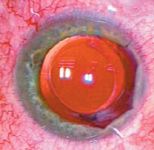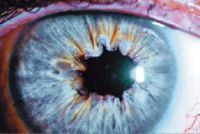Article
Persistent traumatic mydriasis alleviated with cerclage pupilloplasty
A patient complained of severe glare and light sensitivity associated with a persistent traumatic mydriasis of the right eye. After conservative treatment with topical miotics and a painted contact lens failed to decrease the mydriasis, a cerclage pupilloplasty was performed on the right eye resulting in a 4-mm round pupil. The patient experienced significant reduction of glare and photophobia.
A patient complained of severe glare and light sensitivity associated with a persistent traumatic mydriasis of the right eye. After conservative treatment with topical miotics and a painted contact lens failed to decrease the mydriasis, a cerclage pupilloplasty was performed on the right eye resulting in a 4-mm round pupil. The patient experienced significant reduction of glare and photophobia.
History

Examination

Discussion and diagnosis
The differential diagnosis for an abnormally dilated pupil includes Adie's tonic pupil, third cranial nerve palsy, unilateral use of mydriatic eye drops, and iris sphincter damage from trauma. Adie's tonic pupil is caused by postganglionic parasympathetic pupillomotor damage and manifests as an irregular pupil that reacts minimally to light, slowly to convergence, and is slow to redilate. The tonic pupil is supersensitive to weak cholinergic agents. An enlarged pupil from a third cranial nerve palsy will show associated ptosis and motility disturbances. The pupil will not react to weak cholinergic agents but will constrict with regular-strength miotic drops. In the unilateral use of mydriatic drops, the pupil will not react to 1% pilocarpine. Traumatic mydriasis may show torn or damaged areas of iris sphincter, as well as transillumination defects on slit-lamp examination.

As in congenital and developmental defects of the iris, treatment of iris dysfunction following trauma is aimed at decreasing the effective pupillary aperture to reduce the amount of visually disturbing light entering the eye. Several methods have been used to limit the amount of light entering the eye successfully, including colored contact lenses,1 corneal tattoos,2 artificial iris implants,3-6 and iris suture placement to form a smaller, rounder pupil.7-9
Newsletter
Don’t miss out—get Ophthalmology Times updates on the latest clinical advancements and expert interviews, straight to your inbox.





